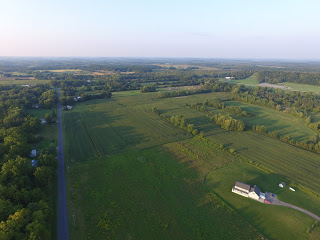| The valley west of the Hill Cumorah in New York |
My previous post about the room in the Hill Cumorah focused on Brigham Young’s comments. He said Joseph Smith and Oliver Cowdery visited a room in the Hill Cumorah that contained numerous records on metal plates and other artifacts. They visited on multiple occasions.
The reason this is important for Letter VII is that if, in fact, Joseph and Oliver (and others) visited a room in the Hill Cumorah that contained the multitude of plates from which Mormon compiled our Book of Mormon, then that corroborates (I would say proves, but proof is in the eye of the beholder) what Oliver wrote in Letter VII.
The existence of the storage room in the New York hill is far more significant than the stone box in which Moroni hid the plates for Joseph to find. It’s one thing for a solitary Moroni to haul plates to New York from somewhere else on the continent (or from another continent). It’s another thing altogether for that same solitary Moroni (or for his father Mormon) to haul wagon loads of plates and other artifacts from somewhere else on the continent, just to store them in the New York hill.
To put it another way, if the room where Mormon hid all the Nephite records (wagon loads of them) was in New York, then Oliver Cowdery had good reason to write that it was a fact that the final battles also took place there–even if he didn’t receive a specific revelation to that effect. And, in that case, Joseph Smith had good reason for endorsing and incorporating Oliver’s account.
I think most readers of the Book of Mormon would agree with that statement. What do you think?
_________________________
Commentator Rory offered this citation to Cameron Packer’s excellent article on the topic that includes nine additional references to the room of records:
http://publications.mi.byu.edu/publications/jbms/13/1/S00006-50be6ae14ef1b5Packer.pdf
Here is the Abstract:
The significance of the Hill Cumorah in the restoration of the gospel goes beyond its identification as the ancient repository of the metal plates known as the Book of Mormon. In the second half of the 19th century, a teaching about a cave in the hill began surfacing in the writings of several leaders of the Church of Jesus Christ of Latter-day Saints. In their view, the hill was not only the place where Joseph Smith received the plates but also their final repository, along with other sacred treasures, after the translation was finished. This article cites ten different accounts, all secondhand, that refer to this cave and what was found there. The author includes a comparison of the accounts that discusses additional records in the cave, God’s dominion over Earth’s treasure, miraculous dealings of God, and the significance of the presence of the sword of Laban.
_____________________
Brigham Young made the point that Oliver didn’t talk about this in public. He also mentioned Hyrum and Don Carlos as having seen the room. The other accounts have Hyrum telling Phelps about it, and so forth. You can read them at the above link.
Some LDS authors have speculated that this was a visionary experience. Yet the accounts refer to multiple visits by multiple people, including Joseph, Oliver, Hyrum, Don Carlos, and David Whitmer.
The two rationales I’ve seen for explaining these accounts as visionary are 1) such a large room cannot exist in a drumlin such as the Hill Cumorah in New York, and 2) the two-Cumorah theory requires that the room full of records be somewhere else.
I don’t find these rationales persuasive because we know there is a stone-lined room in the Hill Cumorah that fits the description–reality trumps theory in this case–and because the two-Cumorah requirement is a rhetorical concept (a circular argument, really), not a requirement of the text.
_____________________
This is another example of the simplest explanation and reconciliation rules.
We have multiple accounts (albeit hearsay) of Joseph, Oliver, and others entering a room in the New York Hill Cumorah that was full of additional plates and other artifacts. We have an actual room in the Hill that matches the description, although empty of artifacts at this point. We have Oliver writing that the final battles of the Nephites took place in the valley west of the New York Hill Cumorah. We have Joseph Smith endorsing Oliver’s account and incorporating it into his own journal. We have multiple reprintings of Oliver’s account while Joseph was alive. We have Joseph alluding to the Hill Cumorah in D&C 128.
The simplest explanation is that the final battles of the Jaredites and Nephites took place in the valley west of the New York Hill Cumorah, just as Oliver wrote. This simple explanation also reconciles all the available evidence.
The two-Cumorah theory requires a series of assumptions. First, that the multiple accounts of Joseph, Oliver, and others entering the room on multiple occasions are all visionary experiences. Second, that it is impossible to have a room in the New York Hill Cumorah. Third, that Oliver was merely speculating about the scene of the final battles, and that when he wrote it was a fact, he was lying or confused or inarticulate. Fourth, when Joseph endorsed and incorporated Oliver’s Letter VII, he, too, was speculating.
I choose the simplest explanation. Others choose the complex explanation. I have no problem with whatever you choose, as readers here, so long as we are all clear on what our choices entail.
In my view, the multiple accounts of multiple people making multiple visits to the room in the New York Hill Cumorah that contained wagon loads of plates and other artifacts effectively corroborate Letter VII. And with Letter VII putting Cumorah in New York, we can work out Book of Mormon geography from there.
Source: Letter VII
